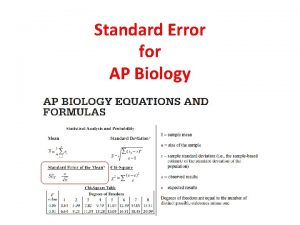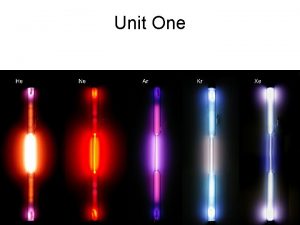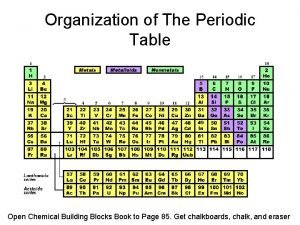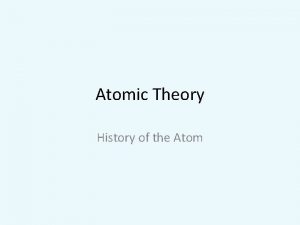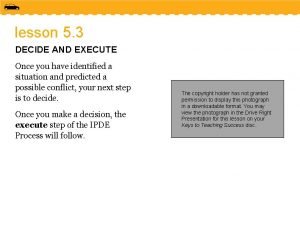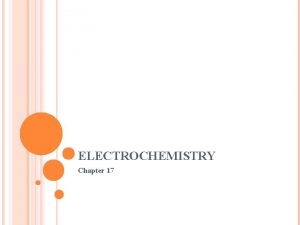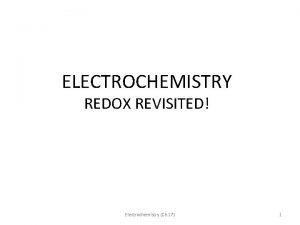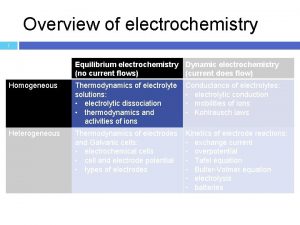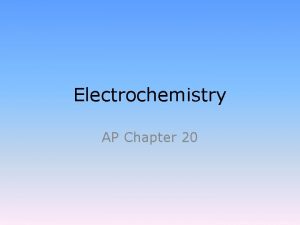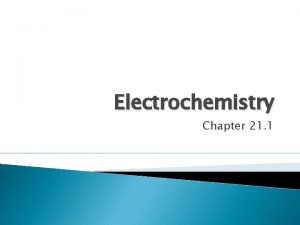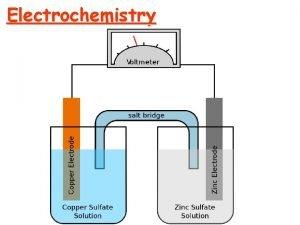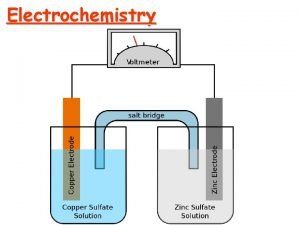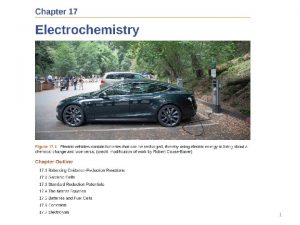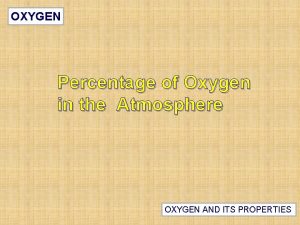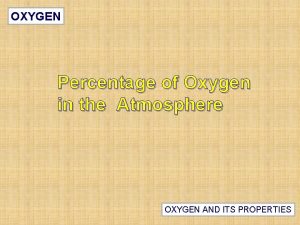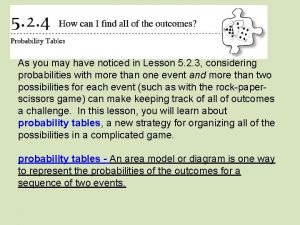Electrochemistry Terminology n You may have noticed oxygen



















- Slides: 19

Electrochemistry

Terminology n You may have noticed oxygen never gets oxidized, it always gets reduced. n The reason for this is because oxygen is an oxidizing agent. n An oxidizing agent is something that causes something else to be oxidized. n An oxidizing agent readily accepts (or takes) electrons from something else. n In the process, the oxidizing agent gets reduced. n A reducing agent is something that causes something else to be reduced.

Electrochemistry n ~The study interactions of chemical and electrical energy. n Electrochemistry deals with 2 types of processes n 1. The production of an electric current from an oxidation reduction reaction n 2. The use of an electric current to produce a chemical reaction.

Production of Current n Oxidation Reactions involve a transfer of electrons. n Electric current is a movement of electrons. n In order to produce a usable current, the electrons must be forced across a set path (circuit). n In order to accomplish this, an oxidizing agent and something to oxidize must be separated from a reducing agent with something to reduce.

Pictures n An Oxidation Reduction reaction in the same container will have electrons Oxidizing agent Reducing Agent transferring, but we can’t harness them. n Separating the oxidation from the reduction, but connecting them by a wire would allow only electrons to flow. Oxidation Reduction

Closer look X → X+ + e. Oxidation X+ + e- → X Reduction n We now have excess electrons being formed in the oxidizing solution and a need for electrons in the reducing solution with a path for them to flow through. n However, if electrons did flow through the wire it would cause a negative and positive solution to form.

That’s not possible n Or at least it would require a lot of energy. n A negative solution would theoretically be formed by adding electrons, and a positive one by removing electrons. n The negative solution would then repel the electrons and stop them from flowing in, and a positive solution would attract the electrons pulling them back where they came from. n Making it so the charged solutions wouldn’t form. n In order for this to work, I would need a way for ions to flow back and forth but keeping the solutions mostly separated.

Salt Bridge n Salt Bridge- a connector for two solutions previously discussed that allows ions to pass back and forth. n This can be accomplished by a tube filled with an electrolyte (positive and negative ions) or a porous disc connecting the two solutions.

Closer look e- e- Salt Bridge X → X+ + e. Oxidation e- X+ + e- → X Reduction n Now electrons can flow across the wire from the oxidation reaction to the reduction reaction. n As the oxidation reaction becomes positive, it removes negative ions and adds positive ions to the salt bridge. n The reduction reaction does the reverse.

Closer look ee- Salt Bridge - ion Oxidation Side e- + ion - ion + ion - ion n Zooming in on the oxidizing side n This would make the salt bridge positive…

e- e- Closer look Salt Bridge - ion + ion e- + ion - ion Reduction side n (Zooming in on the reducing side) n if the reverse wasn’t happening on this side.

Close up of salt bridge - ion + ion + ion - ion + ion - ion n The ions keep flowing in the salt bridge to keep everything neutral. n Electrons do also travel across the salt bridge. n This decreases the cell’s effectiveness.

Electrochemical cell n This is the basic unit of a battery. n It is also called a galvanic cell, batteries have several galvanic cells linked together. n Batteries always have two terminals. n The terminal where oxidation occurs is called the anode. An Ox n The terminal where reduction occurs is called the cathode. Red Cat

Cell Potential (Ecell) n. Cell potential (electromotive force, emf) is the driving force in a galvanic cell that pulls electrons from the reducing agent in one compartment to the oxidizing agent in the other. n. The volt (V) is the unit of electrical potential. n. Electrical charge is measured in coulombs (C). n A volt is 1 joule of work per coulomb of charge transferred: 1 V = 1 J/C. n. A voltmeter is a device which measures cell potential.

How much voltage? n Voltage of a cell depends on the half reactions. n You will have a chart of several half reactions reduction potentials for the test. n Obviously you cannot have two reductions. One will need to be turned into an oxidation. n To do that flip the half reaction and flip the sign of the half reaction.

The Chart

Which reaction to flip n Eocell = Eoreduction + Eooxidation n The Ecell (voltage of the cell) will always be positive. If is negative the cell won’t happen on it’s own. n So if you have a reaction of Zn 2+/Zn and Cu 2+/Cu. n Zn 2+ + 2 e- �Zn E = -. 76 V n Cu 2+ + 2 e- �Cu E =. 34 V

Zinc will need to be flipped to an oxidation to make the cell positive n Zn�Zn 2+ + 2 e- E =. 76 V n Cu 2+ + 2 e- �Cu E =. 34 V n Ecell = 1. 10 V n The overall reaction of the cell is n Zn + Cu 2+ �Cu + Zn 2+

Write the equation for and figure out the electric potential of a cell based on… n Sn 4+/Sn 2+ & Pb 2+/Pb n Sn 4+ + Pb Sn 2+ + Pb 2+ n Eocell =. 15+(. 13) =. 28 V n Zn 2+/Zn & Cr 3+/Cr n 2 Cr 3+ +3 Zn 2+ +2 Cr n Eocell =. 76+(-. 74) =. 02 V (coefficients don’t change this value) n Fe 3+/Fe 2+ & Co 3+/Co 2+ n Fe 2+ + Co 3+ Co 2+ + Fe 3+ n Eocell = 1. 82+(-. 77) = 1. 05 V
 What inclusions have you noticed
What inclusions have you noticed Things i have noticed
Things i have noticed May you be happy in the life you have chosen
May you be happy in the life you have chosen I will follow you follow you wherever he may go
I will follow you follow you wherever he may go I have chosen you and not rejected you
I have chosen you and not rejected you Vocabulary workshop level d unit 12
Vocabulary workshop level d unit 12 A whale watching company noticed that many customers
A whale watching company noticed that many customers The standard error tells biology
The standard error tells biology Figure 17-3 shows smaller and larger beaks
Figure 17-3 shows smaller and larger beaks I may have seen you
I may have seen you Which solid figure has 6 faces 8 vertices and 12 edges
Which solid figure has 6 faces 8 vertices and 12 edges Number of electrons in oxygen
Number of electrons in oxygen How many protons does oxygen have
How many protons does oxygen have How do you determine the number of neutrons in an atom
How do you determine the number of neutrons in an atom History of atom discovery
History of atom discovery You may sit wherever you like
You may sit wherever you like You separate hazards when you adjust your
You separate hazards when you adjust your Emergency move vs rapid extrication
Emergency move vs rapid extrication Whenever you grasp a stretcher or backboard
Whenever you grasp a stretcher or backboard Straddle slide method
Straddle slide method







